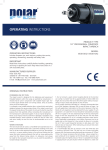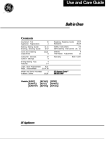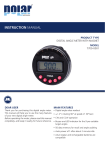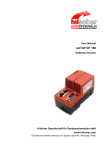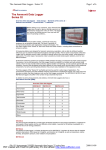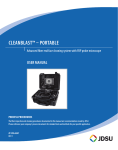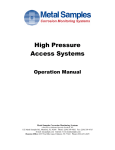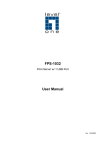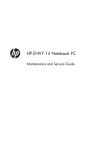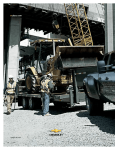Download user manual - PolarTools
Transcript
EC declaration of conformity operating instructions WE: Polar Tools ApS Product type 1/2” professional composite impact wrench Soldalen 9, DK-7100 Vejle, Denmark Declare in sole responsibility that the equipment operating instructions Equipment: Air Impact Wrench Model/Serial No.: 6100-0012 / 6100-1012 Read the operator’s instructions before operating the tool. to which this declaration applies, complies with these normative documents: and conforms to the following EN standards, Important manufacturer/supplier EN ISO 12100:2010 EN ISO 11148-6:2010 Authorized representative established within the EU(if applicable): Company Name: model 6100-0012 / 6100-1012 Read these instructions carefully before installing, operating, servicing or repairing this tool. Keep these instructions in a safe accessible place. Machinery Directive: 2006/42/EC Includes foreseen use, work stations, putting into service, operating, dismantling, assembly and safety rules. Wear eye protection device. Polar Tools ApS Soldalen 9 · DK-7100 Vejle · Denmark Tel: +45 7584 1122 · Fax: +45 6980 4374 E-mail: [email protected] · www.polartools.com Polar Tools Aps Company Address: Soldalen 9, DK-7100 Vejle, Denmark original instruction Person responsible for compiling the technical file established within the EU: Name, Surname: Mikael Linde Address: Jens Grøns Vej 1, DK-7100 Vejle, Denmark Note: This declaration becomes invalid, if technical or operational modifications are introduced without the manufacturers consent. Name and Signature/Position Title Mikael Linde, Owner Wear ear protection device. Date and place Denmark, December 12, 2012 Foreseen Use Of Tool The impact wrench is designed for the tightening and loosening of threaded fasteners within the range as specified by manufacturer. It should only be used in conjunction with suitable impact type 1/2” (13 mm) square female driver nut running sockets. Only use sockets which are of the impact type. It is allowed to use suitable extension bars, universal joints and socket adaptors between the square output driver of the impact wrench and the square female drive of the socket. Do not use the tool for any other purpose than that specified without consulting the manufacturer or the manufacturer’s authorized supplier. To do so may be dangerous. Never use an impact wrench as hammer to dislodge or straighten cross threaded fasteners. Never attempt to modify the tool for other uses and never modify the tool for even its recommended use as a nut runner. Work Stations The tool should only be used as a handheld hand operated tool. It is always recommended that the tool is used when standing on the solid floor. It can be in other positions but before any such use, the operator must be in a secure position having a firm grip and footing and be aware that when loosening fasteners the tool can move quite quickly away from the fastener being undone. An allowance must always be made for this rearward movement so as to avoid the possibility of hand/arm/body entrapment. 1. Do not connect a quick connect coupling directly to the tool but use a whip or a leader hose of say approximately 12 inches (300 mm) length. Do not connect the tool to the airline system without incorporating an easy to reach and operate air shut off valve. The air supply should be lubricated. It is strongly recommended that an air filter, regulator, lubricator (FRL) 1 is used as shown in Figure 1 as this will supply clean, lubricated air at the correct pressure to the tool. Details of such equipment can be obtained from your supplier. If such equipment is nit used then the tool should be lubricated by shutting off the air supply to the tool, depressurizing the line by pressing the trigger on the tool. Disconnect the air line and pour into the intake bushing a teaspoonful (5 ml) of a suitable pneumatic motor lubricating oil preferably incorporating a rust inhibitor. Reconnect tool to air supply and run tool slowly for a few seconds to allow air to circulate the oil. If tool is used frequently lubricate on daily basis and if tool starts to slow or lose power. When lubricating, also ensure that screen in intake bushing is clean. It is recommended that the air pressure at the tool whilst the tool is running at 90 psi/6.3 bar. The tool can run at lower and higher pressure with the maximum permitted working air pressure of 100 psi/ 7.0 bar. For a lower air pressure the tool will give a lower output for a given setting of the sir regulator set for 90 psi/6.3 bar. operation and increased output for higher pressure. Hence it is possible that changes in supply pressure can give situation where the fastener is under over tightened. For changes in pressure, the regulator position and application should be reassessed. It is recommended that joint tightness of the threaded fastener assembly be checked with suitable measuring equipment. Follow the national legislation of waste disposal. Putting Into Service Air Supply Use a clean lubricated air supply that will give a measured air pressure at the tool of 90 psi/ 6.3 bar when the tool is running with the trigger fully depressed And the air regulator in its maximum opening flow position. Use recommended hose size and length. It is recommended that the tool is connected to the air supply as shown in figure 1. FIGURE 1. Take air from top All pipe and fitting should be 1/2” or larger Compressor with sufficient capacity to maintain recommended working pressure at each tool outlet Receiver tank 40 gallons or more Easy to reach and operate shut off valve Air tool Low spot to trap water Air regulator set at recommended working air pressure Drain daily Filter lubricator Drain daily Recommended air supply system Operating The output of the impact wrench in prime working condition is governed by mainly three factors a) The input air pressure 2 b) The time the impact wrench is operated on joint. Normal time for joints of average tension requirement 3 to 5 seconds. c)The setting of air regulator for a given joint at a given pressure operated for a given time. The air regulator can be used to the regulate the output of the impact wrench if no other control means is available. It is strongly recommended that an external pressure regulator ideally as part of a fitter/regulator/ lubricator (FRL) is used to control air inlet pressure so that the pressure can be set to help control the tension required to be applied to the threaded fastener joint. There is no consistent reliable torque adjustment on an impact wrench of this type. However, the air regulator can be used to adjust torque to the approximate tightness of known threaded joint. To set the tool to the desired torque, select an nut or screw of known tightness of the same size, thread pitch and thread condition as those on the job. Turn air regulator to low position, apply wrench to nut and gradually increase power (turn regulator to admit more air) until nut moves slightly in the direction it was originally set. The tool is now set to duplicate that tightness, note regulator setting for future use. When tightness nuts not requiring critical torque values, run nut up flush and then tighten an additional one-quarter to one-half turn(slight additional turning is necessary if gaskets are being clamped). For additional power needed on disassembly work, turn regulator to its fully open position. This impact wrench is rated a bolt size(please refer technical specification of tool). Rating must be down graded for spring U bolts, tie bolts, long cap screws, double depth nuts badly rusted conditions and spring fasteners as they absorb much of the impact power. When possible, clamp or wedge the bolt to prevent spring back. Soak rusted nuts in penetrating oil and break rust seal before removing with impact wrench. If nut does not start to move in three to five seconds use a large size impact wrench. Do not use impact wrench beyond rated capacity as this will drastically reduce tool life. Note: Actual torque on a fastener is directly related to joint hardness, tool speed, condition of socket and the time the tool is allowed to impact. Use the simplest possible tool = to-socket hook up. Every connection absorbs energy and reduces power. Safe Rules When Using an Impact Wrench Read all these safety instructions before operating this product and save these instructions. The tool has been manufactured in conformity with the instruction of EU machine directive. The EU mark will be considered void in the event of inexpert repairs, the use of non-original parts and in case of non-observance of the safety instructions in the user’s manual. General safety rules: 1. Watch the tool at all times when in use. 2. People under the influence of alcohol or drugs are not allowed to use, repair or maintain the tools. 3. Keep unqualified persons, children, etc. away from the tool. 4. Keep work area clean and with sufficient daylight or artificial lighting. The work area on which the machine is used must be cleaned up. Disorder is potential cause of accidents. 5. Danger of explosion. Never use oxygen and combus tible gas as an air supply for the tool which many be ignited by spark and cause fire or explosion. 6. Never use gasoline or other flammable liquids to clean the tool. 7. Do not use air tools in potentially explosive atmos pheres such as in the presence of flammable liquids, cleaning solvents, fluid energy or stored gases. 8. Do not expose air tools to rain. Do not use air tools in damp or wet locations. 9. When a fault or failure is detected, the tool must immediately be disconnected from the air supply and returned for repair. 10.It is not permitted to modify the tool in any way. 11.When not in use, keep tools in a dry place, either loc ked up or i a high place, out of the reach of children. Do not force small air tools to do the job of a heavy duty task. Do not use air tool for purpose of which was not intended. 12.Wear suitable ear protection at environment noise level>80db(A) and safety spectacles when using the tool. Always wear approved safety goggles if work in dusty. This also applies to other persons in the near by vicinity. 13.Do not wear loose clothing or jewelry. They can be caught in moving parts. Rubber gloves and non-skid foot wear are recommended when working out doors. Wear protective hair covering to contain long hair. 14.Keep proper footing and balance at all times. 15.Use clamps or a vice to hold work-piece. It is safer than using your hand and free both hands to operate the air tool. 16.When not use, before performing service or chan ging accessories please disconnect tool from air compressor. 17.Do not carry plugged in air tool with your finger on the switch trigger. Be sure switch is in the “OFF” position when connecting to air supply. 18.Watch what you are doing 19.Use common sense, even unsafe situation or un balanced positions, particularly when you are tired. 20.Air powered tools can vibrate in use. Vibration, repetitive motions or uncomfortable positions may be harmful to your hands or arms. Stop using any tool if discomfort, tingling feeling or pain occurs. Seek medical advice before resuming use. 21.For multiple hazards, read and understand the safety instructions before installing, operating, repairing, maintaining, changing accessories on, or working near the assembly power tool for threaded fasteners. Failure to do so can result in serious bodily injury. 22.Only qualified and trained operators should install, adjust or use the assembly power tool for threaded fasteners. 23.Do not modify this assembly power tool for threaded fasteners. Modifications can reduce the effective ness of safety measures and increase the risks to the operator. 24.Do not discard the safety instructions; give them to the operator. 25.Do not use the assembly power tool for threaded fasteners if it has been damaged. 26.Tools shall be inspected periodically to verify that the ratings and markings required by this part of EN ISO 11148 are legibly marked on the tool. The employer/user shall contact the manufacturer to obtain replacement marking labels when necessary. Safety precautions for projectile hazards 1. Failure of the workpiece, of accessories or even of the inserted tool itself can generate high-velocity projectiles. 2. Always wear impact-resistant eye protection during the operation of the assembly power tool for threa ded fasteners. The grade of protection required should be assessed for each use. 3. Ensure that the workpiece is securely fixed Safety precautions for entanglement hazard 1. Entanglement hazards can result in choking, scal ping and/or lacerations if loose clothing, personal jewelry, neckwear, hair or gloves are not kept away from the tool and accessories. 2. Gloves can be become entangled with the rotating drive, causing severed or broken fingers. 3. Rotating drive sockets and drive extensions can easily entangle rubber-coated or metal-reinforced gloves. 4. Do not wear loose-fitting gloves or gloves with cut or frayed fingers. 5. Never hold the drive, socket or drive extension. 6. Keep hands sway from rotating drives. Safety precautions for operating hazards 1. The use of the tool can expose the operator’s hands to hazards including crushing, impacts, cuts and abrasions and heat. Wear suitable gloves to protect hands. 2. Operators and maintenance personnel shall be physically able to handle the bulk, weight and power of the tool. 3. Hold the tool correctly: be ready to counteract normal or sudden movements and have both hands available. 3 4. 5. 6. 7. Maintain a balanced body position and secure footing. Release the start-and-stop device in the case of an interruption of the energy supply. Use only lubricants recommended by the manufacturer. Do not use in confined spaces and beware of crushing hands between tool and workpiece, especially when unscrewing. Safety precautions for repetitive motions hazards 1. When using a power tool for, the operator can experience discomfort in the hands, arms, shoulders, neck, or other parts of the body. 2. While using an assembly power tool for threaded fasteners, the operator should adopt a comfortable posture whilst maintaining secure footing and avoiding awkward or off-balanced postures. The operator should change posture during extended tasks, which can help avoid discomfort and fatigue. 3. If the operator experiences symptoms such as persistent or recurring discomfort, pain, throbbing, aching, tingling, numbness, burning sensations or stiffness, these warning signs should not be ignored. The operator should tell the employer and consult a qualified health professional. Safety precautions for accessory hazards 1. Disconnect the assembly power tool for threaded fasteners from the energy supply before changing the inserted tool or accessory. 2. Do not touch sockets or accessories during impac ting, as this increases the risk of cuts, burns or vibration injuries. 3. Use only sizes and types of accessories and consum ables that are recommended by the assembly power tool for threaded fasteners manufacturer. 4. Use only impact-wrench-rated sockets in good condition, as poor condition or hand sockets and accessories used with impact wrenches can shatter and become a projectile. Safety precautions for workplace hazards 1. Slips, trips and falls are major causes of workplace injury. Be aware of slippery surfaces caused by the use of the tool and also of trip hazards caused by the air line or hydraulic hose. 2. Proceed with care in unfamiliar surroundings. Hidden hazards, such as electricity or other utility lines, can exist. 3. The assembly power tool for threaded fasteners is not intended for use in potentially explosive atmos pheres and is not insulated against coming into contact with electric power. 4. Make sure there are no electrical cables, gas pipes, etc., that can cause a hazard if damaged by use of the tool 4 Safety precautions for dust and fume hazards 1. Dust and fumes generated when using assembly power tools for threaded fasteners can cause ill health (for example, cancer, birth defects, asthma and/or dermatitis); risk assessment and implementation of appropriate controls for these hazards are essential. 2. Risk assessment should include dust created by the use of the tool and the potential for disturbing existing dust. 3. Direct the exhaust so as to minimize disturbance of dust in a dust-filled environment. 4. Where dust or fumes are created, the priority shall be to control them at the point of emission. 5. All integral features or accessories for the collection, extraction or suppression of airborne dust or fumes should be correctly used and maintained in accor dance with the manufacturer’s instructions. 6. Use respiratory protection in accordance with employer’s instructions and as required by occupa tional health and safety regulations the assembly power tool for threaded fasteners, tell your employer and consult a physician. 5. Operate and maintain the assembly power tool for threaded fasteners as recommended in the instruc tion handbook, to prevent an unnecessary increase in vibration levels. 6. Do not use worn or ill-fitting sockets or extensions, as this is likely to cause a substantial increase in vibration. 7. Select, maintain and replace the consumable/inser ted tool as recommended in the instruction hand book, to prevent an unnecessary increase in vibra tion levels. 8. Sleeve fittings should be used where practicable. 9. Support the weight of the tool in a stand, tensioner or balancer, if possible. 10.Hold the tool with a light but safe grip, taking account of the required hand reaction forces, because the risk from vibration is generally greater when the grip force is higher. Safety precautions for noise hazards 1. Unprotected exposure to high noise levels can cause permanent, disabling hearing loss and other pro blems, such as tinnitus (ringing, bussing, whistling or humming in the ears). 2. Risk assessment and implementation of appropriate controls for these hazards are essential. 3. Appropriate controls to reduce the risk may include actions such as damping materials to prevent work pieces from “ringing”. 4. Use hearing protection in accordance with emplo yer’s instructions and as required by occupational health and safety regulations. 5. Operate and maintain the assembly power tool for threaded fasteners as recommended in the instruc tion handbook, to prevent an unnecessary increase in noise levels. 6. If the assembly power tool for threaded fasteners has a silencer, always ensure it is in place and in good working order when the assembly power tool for threaded fasteners is operating. 7. Select, maintain and replace the consumable/inser ted tool as recommended in the instruction hand book, to prevent an unnecessary increase in noise. Additional safety instructions for pneumatic power tools 1. Always shut of air supply, drain hose of air pressure and disconnect tool from air supply when not in use, before changing accessories or when making repairs. 2. Never direct air at yourself or anyone else. 3. Whipping hoses can cause severe injury. Always check for damaged or loose hoses and fittings. 4. Cold air shall be directed away from the hands. 5. Do not use quick-disconnect couplings at tool inlet for impact and air-hydraulic impulse wrenches. Use hardened steel (or material with comparable shock resistance) threaded hose fittings. 6. Whenever universal twist couplings (claw coup lings) are used, lock pins shall be installed and whip check safety cables shall be used to safeguard against possible hose-to-tool and hose-and hose connection failure. 7. Do not exceed the maximum air pressure stated on the tool. 8. For torque-control and continuous-rotation tools, the air pressure has a safety critical effect on per formance. Therefore, requirements for length and diameter of the hose shall be specified. 9. Never carry an air tool by the hose. Safety precautions for vibration hazards 1. Exposure to vibration can cause disabling damage to the nerves and blood supply of the hands and arms. 2. Keep the hands away from the sockets. 3. Wear warm clothing when working in cold condi tions and keep your hands warm and dry. 4. If you experience numbness, tingling, pain or white ning of the skin in your fingers or hands, stop using Warning 1. The tool shall not be used in explosive atmospheres unless specially designed for that purpose. 2. The tool is not electrically insulated. Do not use where there is a possibility of coming into contact with live electricity. 3. Unexpected tool movement due to reaction forces or breakage of inserted tool or reaction bar may cause injuries. 4. Preferably shut off the air supply before changing socket or at least ensure that the hands are well clear of the operating trigger. 5. Be aware of the risk of crushing by torque between a reaction bar and the workplace. 6. When loosening fasteners first ensure that there is sufficient clearance behind the tool to avoid hand entrapment. The tool will move away from the threaded joint as the nut/bolt etc. is loosened and rides up the thread moving the tool with it. 7. There is a risk of being injured specially when unscrewing in confined work place if hands are not kept away from the reaction bar. Keep hands sway from the nut runner socket. 8. In case of nut runner socket failure, it may danger to person from high speed splinters being emitted from impact wrench. 9. Be aware of the whipping compressed air hose. 10.Always ensure that the reverse valves is in the correct position before operating the tool. Do not run the tool unless the socket is first located on the joint. 11.Prevent the loose clothes, long hair, or any other personal accessories from closing to the moving part to reduce the risk of being caught trapped or drawn in the rotating spindle. Maintenance instruction 1. Dry the filter and the air inlet of the tool. 2. Lubricate the quick connect coupling to prevent blocking. 3. Air tool require lubrication throughout the life of the tool. The air motor and bearing uses compres sed air to start the tool. The moisture in compres sed air will rust the air motor; you must lubricate the motor daily. 4. Avoid storing the tool in a location subject to high humidity. If the tool is left as it is used, the residual moisture inside the tool can cause rust. 5. Before storage, lubricate tool and run it for a few seconds. 6. Regular inspection of spindles, threads, and clam ping devices in respect of wear and tolerances for location of abrasive products. 7. If the tool is too seriously damage to be used any more, recycle raw material instead of disposing as waste. The machine, accessories and packaging should be sorted for environmental-friendly recyc ling. Check with your local authority or retailer for recycling advice. 5 6100-0012 1/2” stubby composite impact wrench 00-0012 ½” Stubby Composite Impact Wrench 6100-1012 1/2” composite impact wrench 6100-1012 ½” Composite Impact Wrench PARTS NO.Description PARTS NO.Description P6100-0012-01 Oil Seal P6100-1012-01 P6100-0012-02 Regulator Knob P6100-1012-02Hammer Case P6100-0012-03Hammer Case P6100-1012-03Bushing P6100-0012-04Bushing P6100-1012-04 P6100-0012-05 P6100-1012-05O-Ring Anvil Collar P6100-1012-06Anvil P6100-0012-07 P6100-1012-07Hammer Cage Anvil (1/2” DR) P6100-0012-08Hammer Pin (2) ¢ P6100-1012-08Hammer Pin (2) ¢ P6100-0012-09Hammer Dog (2) P6100-1012-09Hammer Dog (2) P6100-0012-10Hammer Cage P6100-1012-10Washer P6100-1012-11 Front Gasket ¢ P6100-0012-12Motor Housing P6100-0012-13O-Ring l P6100-1012-13O-Ring l P6100-0012-15 P6100-1012-14 DESCRIPTION Q'TY PARTS NO. DESCRIPTION 0985TA02 Regulator Knob 1 0985TA03 Hammer Case 1 MODEL: 6100-0012 0985TA04 Bushing 1 0985TA05 Anvil Collar 1 0985TA06 O-Ring 9000 ± 10% 1 RPM (r/min): 0985TA07 Anvil (1/2" DR) 1 0985TA08 Hammer Pin 2 WEIGHT: 1.30 kg 2.87 lbs 0985TA09 Hammer Dog 2 0985TA10 Hammer Cage 1 AIR PRESSURE: 6.3 bar (90 PSI)1 0985TA11 Front Gasket 0985TA12 Motor Housing 1 0985TA13 O-Ring maximum 1 recommended 0985TA14 Washer 30 ft / 10 m 1 hose length: 0985TA15 Ball Bearing 1 0985TA16 Cylinder 1 recommended minimum hose bore 0985TA17 diameter:Spring Pin 3/8” / 10 mm1 0985TA18 Rotor Blade 6 0985TA19 Rotor 1 Noise level: 0985TA20 Rear Plate 1 LOADNO LOAD 0985TA21 Ball Bearing 1 89.1 dB(A) 0985TA22 Rear Gasket94.2 1 SOUND pressure 0985TA24 Screw 0985TA25 O-Ring 2 vibration 9.69 0985TA26 level: Steel Ball m/sec 0985TA27 Spring Measurement 0985TA28 Reverse Valve uncertainty: KTrigger = 1.5 m/sec2 0985TA29 0985TA30 O-Ring Tested in accordance 0985TA31 Muffler with Retainer EN0985TA32 ISO 28927-2 0985TA33 Valve Stem 0985TA34 Spring other data: Exhaust Deflector air0985TA35 inlet 1/4” (6.3 mm) 0985TA36 O-Ring bolt capacity 1/2” 0985TA37 Washer 13 mm 0985TA38A Hose Adaptor -18NPT 0985TA38B Hose torque 450Adaptor ft. lb-19PT 0985TA38C Hose Adaptor -19PF(BSP) 62 kg/m 610 Nm average air consumption 120 L/min. (4,2 cfm) level overall length 4.81” (122 mm) sound power 105.2 100.1 dB(A) overall width 2.52” (64 mm) leveL overall height 7.80” (198 mm) square drive 1/2” Measurement uncertainty: K = 3dB clutch type Twin hammer Tested in accordance with EN ISO 15744 Recommended Personal Safety Equipment 6 Ball Bearing USE: Safety glasses and ear protectors P6100-0012-17 Spring Pin P6100-0012-18 Rotor Blade (6) l Q'TY 1 P6100-0012-19Rotor 4 1 P6100-0012-20 Rear Plate 1 P6100-0012-21 Ball Bearing 1 1 P6100-0012-22 Rear Gasket ¢ 1 P6100-0012-23 Rear Cover 1 1 P6100-0012-24 Screw (4) 1 l P6100-0012-25O-Ring 1 1 P6100-0012-26 Steel Ball 1 P6100-0012-27Spring 1 1 P6100-0012-28 Reverse Valve P6100-0012-29Trigger 1 P6100-0012-30O-Ring l P6100-0012-31Muffler P6100-0012-32Retainer P6100-0012-33 Valve Stem P6100-0012-34Spring P6100-0012-35 Exhaust Deflector P6100-1012-16 Technical specification PARTS NO. 1285TA01 1285TA02 1285TA03 1285TA04 1285TA05 1285TA06 1285TA07 1285TA08 1285TA09 1285TA10 1285TA11 1285TA12 1285TA13 1285TA14 1285TA15 1285TA16 1285TA17 1285TA18 1285TA19 1285TA20 1285TA21 1285TA22 DESCRIPTION Q'TY Hammer Case 1 Bushing 1 MODEL: 6100-1012 Anvil Collar 1 O-Ring 1 RPM (r/min): Anvil 6500 ± 10% 1 Hammer Cage 1 Hammer Pin WEIGHT: 2.02 kg 4.45 lbs 2 Hammer Dog 2 Washer 1 AIR PRESSURE: 6.3 bar (90 PSI) Front Gasket 1 Motor Housing 1 recommended maximum O-Ring 1 hose length: 30 ft / 10 m 1 Steel Ball Spring 1 Reverse Valve minimum hose bore 1 recommended Retainer 1 diameter: 3/8” / 10 mm Valve Stem 1 Spring 1 Noise level: 1 Exhaust Deflector LOADNO LOAD O-Ring 1 96.1 91.6 dB(A) SOUND pressure Washer 1 level sound power 107.1 102.6 dB(A) leveL Measurement uncertainty: K = 3dB P6100-0012-37Washer Tested in accordance with EN ISO 15744 P6100-0012-40 l Service Kit P6100-0012-41 ¢ Rebuilt Kit Recommended Personal Safety Equipment Reverse Valve P6100-1012-17Retainer PARTS NO. product type Oilprofessional Seal 1 1285TA23A 1/2” composite impact wrench P6100-0012-36O-Ring ¢ P6100-0012-38AHose Adaptor -18NPT Steel Ball P6100-1012-15Spring P6100-0012-16Cylinder product type 0985TA01 Oil Seal 1 0985TA23 Rear Cover 1/2” stubby professional composite impact wrench Front Gasket ¢ P6100-1012-12Motor Housing P6100-0012-14Washer PARTS NO. Anvil Collar P6100-0012-06O-Ring P6100-0012-11 Technical specification Oil Seal DESCRIPTION Hose Adaptor -18NPT 1285TA23B Hose Adaptor -19PT 1285TA23C Hose Adaptor -19PF(BSP) vibration 9.44 m/sec2 1285TA24 level: Muffler 1285TA25 Regulator Knob Measurement 1285TA26 Trigger uncertainty: K = 1.5 m/sec2 1285TA27 O-Ring 1285TA28 O-Ring Tested in accordance 1285TA29 Ball Bearing with EN ISO 28927-2 1285TA30 Oil Seal 1285TA31 Cylinder other data: Spring Pin 1285TA32 1285TA33 Rotor Blade air inlet 1/4” (6.3 mm) 1285TA34 bolt capacityRotor 5/8” 1285TA35 Rear16 Plate mm 1285TA36 Ball Bearing torque ft. lb 1285TA37 Rear900 Gasket 1285TA38 Rear125 Coverkg/m 1220 Nm 1285TA39 Screw average air consumption overall length overall width overall height square drive clutch type USE: 140 L/min. (4.8 cfm) 6.50” (122 mm) 2.88” (64 mm) 8.27” (198 mm) 1/2” Twin hammer Safety glasses and ear protectors Q'TY P6100-1012-18 Valve Stem P6100-1012-19Spring 1 P6100-1012-20 Exhaust Deflector ¢ 1 P6100-1012-21O-Ring 1 1 P6100-1012-23AHose Adaptor -18NPT 1 1 P6100-1012-24Muffler 1 P6100-1012-25 Regulator Knob 1 1 P6100-1012-26Trigger 1 l P6100-1012-27O-Ring 6 l 1 P6100-1012-28O-Ring 1 P6100-1012-29 Ball Bearing 1 P6100-1012-30 Oil Seal 1 1 P6100-1012-31Cylinder 4 P6100-1012-22Washer P6100-1012-32 Spring Pin P6100-1012-33 Rotor Blade (6) l P6100-1012-34Rotor P6100-1012-35 Rear Plate P6100-1012-36 Ball Bearing P6100-1012-37 Rear Gasket ¢ P6100-1012-38 Rear Cover P6100-1012-39 Screw (4) P6100-1012-40 l Service Kit P6100-1012-41 ¢ Rebuilt Kit 7




